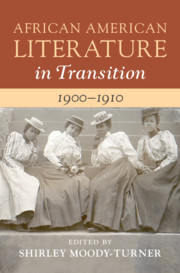Book contents
- African American Literature in Transition, 1900–1910
- African American Literature in Transition
- African American Literature in Transition, 1900–1910
- Copyright page
- Contents
- Figures
- Contributors
- Preface
- Acknowledgments
- Chronology, 1900–1910
- Introduction
- Part I Transitions in African American Authorship, Publishing, and the Visual Arts
- Chapter 1 Black Bibliographers and the Category of Negro Authorship
- Chapter 2 Transitions in African American Book Publishing and Print Culture
- Chapter 3 Reevaluating African American Art before the Harlem Renaissance
- Part II New Negro Aesthetics and Transitions in Genre and Form
- Part III Modernist Masculinities and Transitions in Black Leadership
- Part IV Remapping the Turn of the Twentieth Century
- Index
Chapter 1 - Black Bibliographers and the Category of Negro Authorship
from Part I - Transitions in African American Authorship, Publishing, and the Visual Arts
Published online by Cambridge University Press: 29 April 2021
- African American Literature in Transition, 1900–1910
- African American Literature in Transition
- African American Literature in Transition, 1900–1910
- Copyright page
- Contents
- Figures
- Contributors
- Preface
- Acknowledgments
- Chronology, 1900–1910
- Introduction
- Part I Transitions in African American Authorship, Publishing, and the Visual Arts
- Chapter 1 Black Bibliographers and the Category of Negro Authorship
- Chapter 2 Transitions in African American Book Publishing and Print Culture
- Chapter 3 Reevaluating African American Art before the Harlem Renaissance
- Part II New Negro Aesthetics and Transitions in Genre and Form
- Part III Modernist Masculinities and Transitions in Black Leadership
- Part IV Remapping the Turn of the Twentieth Century
- Index
Summary
The turn of the century saw a massive effort to establish the category of “negro” authorship, centering African Americans not just as writing subjects but also as deeply involved in the project of building the infrastructure to recognize the existence of a long, dynamic, and expansive tradition of “Negro” literature. This chapter shows how, through their work in bibliography, familiar figures such as Daniel Murray, W. E. B. Du Bois, and later Dorothy Porter established the existence of an African American literature and sought to organize and categorize it to include a range of works that documented a “blackness” understood beyond “the Negro problem.” This chapter illustrates the constructed nature of categories such as “Negro literature” or “African American author,” while also bringing attention to the role of African Americans in imagining the possibilities of a much broader category of literature that would get constricted and delimited in subsequent iterations, reminding us that definitions of African American literature were not “inevitable” and that there was a moment at turn of the century when African American literary workers were imagining much broader possibilities.
Keywords
- Type
- Chapter
- Information
- African American Literature in Transition, 1900–1910 , pp. 23 - 47Publisher: Cambridge University PressPrint publication year: 2021

